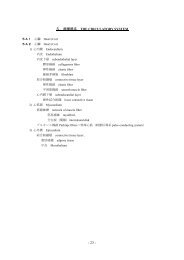Program / Abstract Book - KMU WWW3 Server for Education ...
Program / Abstract Book - KMU WWW3 Server for Education ...
Program / Abstract Book - KMU WWW3 Server for Education ...
You also want an ePaper? Increase the reach of your titles
YUMPU automatically turns print PDFs into web optimized ePapers that Google loves.
No. 27 (PI 1)<br />
Combination of Anti-HCV Assay to Improve Per<strong>for</strong>mance of Hepatitis C Screening<br />
Test in Prodia National Reference Laboratory, Indonesia<br />
Romimatul Fadhilah, Yenny Surjawan, Indriyanti R. Sukmawati<br />
Prodia Clinical Laboratory, Indonesia<br />
Anti-HCV assay <strong>for</strong> hepatitis C screening test has been widely used. Based on CDC guideline (2003),<br />
positive anti-HCV screening result has to be verified by immunoblotting assay or nucleic acid testing. In<br />
fact, not all laboratories in Indonesia have facilities to per<strong>for</strong>m this test. Prodia National Reference<br />
Laboratory received samples <strong>for</strong> anti-HCV screening test from its hundred branches. Samples sources<br />
were from vary population with varying prevalence of hepatitis C. In our experience, samples referred<br />
<strong>for</strong> anti-HCV assay from other laboratories quite often showed discordance results with ours. Previous<br />
evaluation of 4 automated analyzers <strong>for</strong> anti-HCV assay by Kim et al (2008) showed good sensitivity<br />
(100 %), but 3.7 % still showed false positive results. There<strong>for</strong>e an evaluation of routine anti-HCV<br />
screening test should be per<strong>for</strong>med. We evaluated 55 samples using 3 analyzers (Advia Centaur,<br />
Architect-i2000 and Axsym). Seventeen samples that showed discordant results among analyzers or had<br />
extreme low and high index or s/co were confirmed by immunoblotting assay using INNO-LIA TM HCV<br />
Score reagent (Innogenetics). The sensitivity of anti-HCV assay on those 3 analyzers was good (100 %).<br />
False positive results were found in 4 samples by Architect, 5 samples by Advia and 5 samples by<br />
Axsym. The assay showed a different result if a sample, especially sample with low s/co ratio or index,<br />
was examined with different analyzers. The false positive results were not found in the same samples<br />
and there were no specific pattern. There<strong>for</strong>e, we consider using a second anti-HCV assay as<br />
recommended by UK Health Protection Agency algorithm (2007) <strong>for</strong> results with low s/co ratio or index<br />
to reduce the possibility of false positive result.<br />
- 80 -



